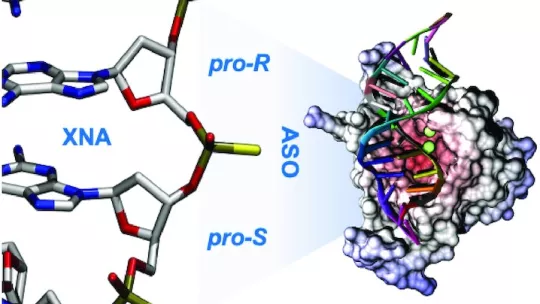Images
● Researchers at IRB Barcelona and the biotech Nostrum Biodiscovery, with the collaboration of other companies such as Biogen, and Ionis have laid the groundwork for the systematic development of optimal RNA-binding inhibitors based on antisense oligonucleotide technology.
● The research has been published in the journal Nucleic Acids Research.
Proteins are large, complex molecules that play many critical roles in the body and are produced following the instructions encoded in DNA. By reading their DNA letters, cells produce an intermediate RNA molecule that will give rise to the corresponding protein. Most diseases occur with altered protein levels, which are either a cause or consequence of the condition itself. RNA plays a pivotal role in diseases with altered protein levels by serving as the intermediary messenger between DNA and protein.
Recent years have seen increased research efforts devoted to targeting RNA molecules to block protein production to restore various conditions, with some drugs already on the market for this purpose. Researchers led by Dr. Modesto Orozco in the Molecular Modelling and Bioinformatics lab at IRB Barcelona and the biotech company Nostrum Biodiscovery have performed extensive computational and experimental analyses to produce predictive models capable of determining the structure, stability, flexibility and biology of the RNA-targeting drugs to modulate the expression of certain pathogenic proteins. These RNA-binding molecules themselves are also DNA-based strands and are called oligonucleotides that, by exploiting the Watson-Crick base-pairing model, recruit the target RNA thus impeding its functioning.
Published in Nucleic Acids Research, the study involved extensive computational and experimental analyses, the latter performed at the Experimental Bioinformatics Laboratory, headed by Dr. Isabelle Brun Heath at IRB Barcelona. The team validated their predictions in vitro and achieved outstanding results. It was carried out in collaboration with the leading international biotech companies Biogen and Ionis Pharmaceuticals, as well as with the Department of Inorganic and Organic Chemistry at the University of Barcelona and the Instituto de Química Física Rocasolano in Spain.
“The project aims to lay down the guidelines for developing optimal oligonucleotides to target this intermediate step in, potentially, any protein production process. We now know some of the specific modifications these molecules must undergo to improve thermostability, specificity, and sensitivity to degradation by cellular mechanisms,” explains Dr. Orozco, also a Professor at the Department of Biochemistry and Biomedicine at the Universitat de Barcelona.
“The simulation tools we have developed are an example of precision engineering since we have systematically looked at every possible modification in every position of the candidate molecules in order to amplify its function. This work has only been possible thanks to the technology available at Nostrum Biodiscovery and the key collaboration of first-class partners, such as Biogen and Ionis Pharmaceuticals,” says Dr. Vito Genna, a former postdoctoral researcher at IRB Barcelona and now Director of the Nucleic Acids Department at Nostrum Biodiscovery.
So far, research into these oligonucleotides has been fully experimental as it is a cumbersome process. The biotech company will now further develop these predictors to build a machine-learning suite to guide researchers working on this kind of therapy, allowing them to save time and money.
Three bases for the development of effective inhibitors
In the search for effective therapeutic oligonucleotides, the researchers have identified three crucial features of any candidate. Firstly, the molecule should form stable hybrids when paired with the corresponding RNA molecule—a process that requires both thermostability and stability over time. Secondly, it should be resistant to serum nucleases—a property that extends its availability within the body. Lastly, the oligonucleotide should produce hybrids that are sensitive to RNase H degradation, which is the cellular mechanism responsible for removing RNA molecules and preventing protein formation. These three key features provide a valuable framework for developing oligonucleotides that can effectively target and treat diseases by regulating protein production.
A therapeutic approach that could potentially address a wide range of conditions
A therapeutic approach with the potential to address a wide range of conditions is emerging that interacts with the protein expression pathway and has transversal applicability. This therapy could be used to target any disease related to the overexpression of a given protein or the expression of aberrant forms of proteins, including infectious diseases that undergo the expression of pathogenic proteins in human cells.
This broad scope has generated great interest in this kind of therapy in recent years, partly due to the relatively easy manipulation of these molecules, their small size, and their cost-effectiveness.
To further advance this therapeutic approach, the researchers will now validate their results in cell cultures and aim to develop an optimal standard that can be used as a basis to target a variety of DNA-RNA hybrids, block a range of proteins, and treat related diseases.
Related article:
Controlled Sulfur-Based Engineering Confers Mouldability to Phosphorothioate Antisense Oligonucleotides
Vito Genna, Javier Iglesias, Laura Reyes-Fraile, Nuria Villegas, Kevin Guckian, Punit Seth, Brad Wan, Cristina Cabrero, Montserrat Terrazas, Isabelle Brun-Heath, Carlos González, Simone Sciabola, Anabella Villalobos and Modesto Orozco
Nucleic Acids Research (2023) DOI: 10.1093/nar/gkad309
About IRB Barcelona
The Institute for Research in Biomedicine (IRB Barcelona) pursues a society free of disease. To this end, it conducts multidisciplinary research of excellence to cure cancer and other diseases linked to ageing. It establishes technology transfer agreements with the pharmaceutical industry and major hospitals to bring research results closer to society, and organises a range of science outreach activities to engage the public in an open dialogue. IRB Barcelona is an international centre that hosts 400 researchers and more than 30 nationalities. Recognised as a Severo Ochoa Centre of Excellence since 2011, IRB Barcelona is a CERCA centre and member of the Barcelona Institute of Science and Technology (BIST).











